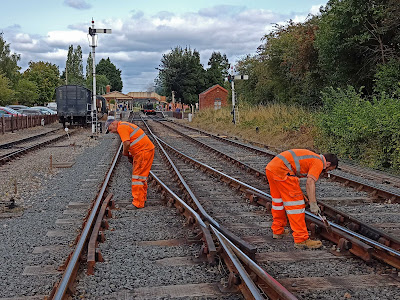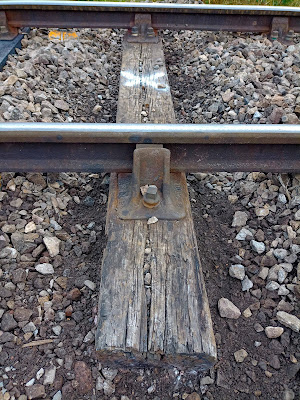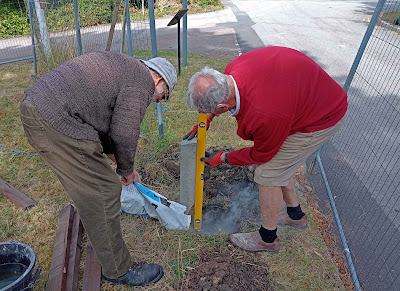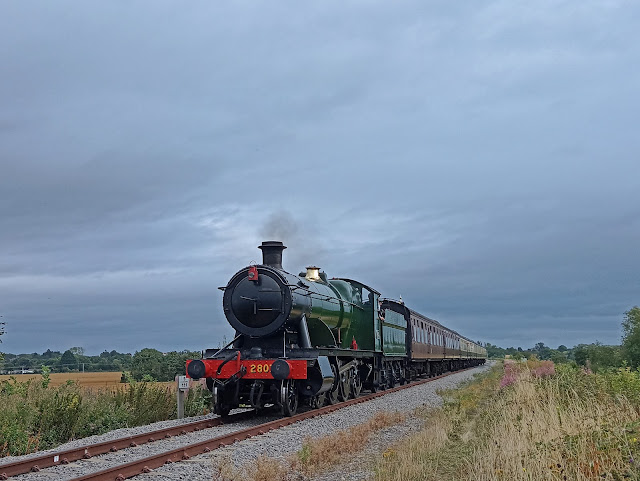Friday at Broadway.
A good day for brick laying, but also for... blackberrying.
It was getting hotter again, and on leaving the spiderweb covered Broadway signal box we spotted a rich offering of blackberries.
So it's not all hard work.
Good news on the building supplies front, where one of our orders has finally come in.
Here is a big pile of insulation, and in other good news there was a roll of DPC too, which was immediately used along the back of the new building.
The Friends of Broadway have purchased 6 more lamp tops from a coppersmith. These are destined to go on the northern half of P2.
As this is still a building site we have put the new tops into store, as there is too great a risk of damage if we put them up already.
Prior to that we painted them black, on a layer of etch primer, exchanged the mild steel bolts for stainless ones with nylon insulating rings, and arranged for the name BROADWAY to be attached to two each of the four panes of glass in a lamp top. So we are ready to go.
Here is one of the 6 empty posts, with in the background one of the replacement pine trees, clearly flourishing, with new shoots all over. The grass is neatly mown by Pat of the Broadway gang.
Work on Friday consisted of a mix and a half made, and almost all of the
rear now completed with the second course of blues. A lot of mortar was
used bedding down the DPC.
In the picture the last stretch of DPC has been placed, with the roll in the RH corner. Bricks laid on Friday on the DPC almost reach the corner now.
Saturday, out with the gang.
A very enjoyable day. Good weather, dry, not too warm, satisfying jobs and good company.
Satisfying jobs... the first job was to work our way through these goodies. Some were provided by Bert Ferrule, some by Yours Truly as a prize for Dave correctly guessing a WhatsApp quiz question, and the brownies were home made by David, and are always eaten first. They are great!
 |
How does this work then?
|
We have a new blue Transit, as the white crew cab failed its MOT. This is a generation younger than the previous model, so the first thing to do was discover how some of the extras worked.
No, you can't open the flap if the step is down...
Here is the step down at last, after opening the little flap for it first. Previously there was a folding step inside the main dropside, but that has gone.
Or you can just climb on.
The job on Saturday was to correct a rolling motion reported by the loco crews at Peasebrook. It was very subtle, not immediately apparent from an approaching Ranger, but luckily it had been measured earlier and the deviations drawn in mm on the side of the rail. Handy.
Of course we work between trains, so we waited for the up train to go to Broadway, and return 15 minutes later. Then we got to work.
The drop was on the Malvern side, and extended over two panels. The old way (2 years ago) would have been to dig out each sleeper (50 in two panels) and then use manual beaters to hammer the ballast into each void once the track was lifted.
Manual beating is extremely taxing, so a handful of sleepers done would have been the maximum.
Now we have the Robels, and productivity has boomed. We lifted the two panels to the correct height again, and tamped all 50 sleepers in one go, using all four Robels that we now have. We were done by lunch time, so up for another job too.
After being accused last year by a neighbouring horse owner lady that we were 'laughing and wearing orange' (!), we were wondering what these horses below (not the same property by the way) would do when the 4 Robels were used.
Graze quietly, and sleep was the answer.
Dinmore Manor also came by at Peasebrook. Enjoy the picture, as the Manor is going to fall out of ticket by the end of the year.
Then it was lunch time, and we had to go back. Forward was no good for the new truck, as it passes over an awkward crossing, difficult to negotiate even for a 4WD vehicle.
Backwards was a long way.
Dave thought he could turn it in a disused crossing entrance, which was covered in grass and had a big hole on one corner.
He got away with it - phew!
More than once the whole gang has had to mass behind a Transit, and give it a rescuing shove.
We assembled on the terrace of the mess room at Toddington. Smoke rose from the yard - what was that?
It was 3850, on a steam test. Nearly ready now, a lovely all black engine.
Despite having done the job at Peasebrook, we thought we'd have another go at one, which was nearby at Toddington south. There were two sleepers that needed replacing (second hand when they went in, during the 1980s) and this is us prepping the site, by digging out around them. Then it was waiting for the down train to pass by.
This duly arrived, headed by 2807. This drifted along with the regulator closed, as it was within station limits. The regulator is about to be opened though, see the 25mph sign on the right.
We got a 10 minute line block, and before the up train with Dinmore Manor came back the other way we had both sleepers out, and replaced with better second hand examples. Not new wood; older, second hand ones will probably last longer.
So second job done, as the heat began to mount when the sun came out. Time to head for the Coffeepot, our end of the day treat.
We went inside and placed a bulk order - Nine teas, please.
Shortly after that, 37 215 rumbled in. Winchcombe is a busy station that time of day, it's lovely to watch.
Monday, with a special train.
This was the hot one! There were 4 Pwayers, two drivers, and a guard. The class 20 took the two Elk rail wagons to Dixton cutting, to recover the rail that we put to one side after it failed the ultrasonic tests.
First thing, we saw two bulk carriers bring some stone in, which was dropped in front of the S&T building.
Then, before starting the day, we used some spare 'corporate' GWSR stickers to equip the two new vehicles recently acquired by the company.
 |
Picture by Simon Coleman
|
There - that's the new Transit seen to, and we did the Mercdes panel sided van (for the catering department) as well.
Then we had the option of travel in the Ranger, or the train. We chose train !
Two pictures of the rail recovery train, approaching, and then leaving, Greet tunnel. The class 20 was whistling away merrily.
The train went to Gotherington Skew yard, the reversed back to the start of Dixton cutting, to move slowly forward again.
Last week we collected the rail into bundles of 4, so that made it faster for Monday, when 4 rails could be lifted in, without moving the Telehandler.
Lifting the first rail up disturbed a tiny mouse.
Its eyes were still closed, so still a baby mouse. Paul lifted it off the ground to show us.
Then we noticed a little nest on the ground, where the rail had been. It had two more baby mice in it.
We dropped the first baby mouse in with its mates, then covered the nest with some straw, and moved on. Hopefully the mother will return.
Lunch was held 'al fresco' - just 15 minutes to eat your snap, the pick up the rest of the rails and trundle back home.
Here is a trackside view of a proper freight train on our railway.
We loaded 19 rails on the first Elk. These are all FB in reasonable condition, were it not for some squats which caused the rails to fail an ultrasonic examination a couple of years ago. They should be fine for sidings though.
The rails are in 60 ft lengths (mostly) with drilled fishplate holes, ready for laying in someone's yard or C&W carriage shed project. They are worth £180 each in scrap, but for the same money we are willing to let them go to a preservation project somewhere - drop us a line via the blogger contact form above.
The second Elk, already partly loaded with our stock of reserve new rail lengths, was added to with 4 of the s/h ones, and two unused new lengths that were in the cess.
Then, with an air temperature of 29C, it was at last time to return home. From the train we spotted a new building site up against our property line, with Bradstone packages giving an idea of the sort of buildings proposed here.
We later learned that 4 houses will be built, at the bottom of our embankment.
We paused the train by the outer home, for a quick chat with the signalman, who then authorised us to proceed.
We entered the PWay yard via platform 2 at Winchcombe, put away the tools and then it was homeward bound.
On the way home we stopped near Broadway to speak to a farmer, who had told us that his father recovered some of the materials of old Broadway station during the demolition.
He mentioned marble like ballast that was shiny - we believe this to be slagstone, which the GWR used to bind the underlying clay. That recovered ballast is now underneath his driveway.
Wood from the station building was used to construct a shed, but it no longer exists after it was burned, he told us.
Several enamel advertising signs were recovered from the goods shed, he said. We were puzzled by this, as we have never seen enamel signs in use anywhere along the Honeybourne line. But he certainly had enamel signs - here are two of them.
We liked the PARK DRIVE cigarette advertisement, as it gives a price (no inflation in the 1950s then...).
So it was 5 cigarettes for 2d.
We recall that during our own school days the corner shop sold individual Woodbines to schoolchildren. Well, the poor things couldn't afford a whole packet, so what can you do?
The farmer also had an array of what looked like old PWay tools, including an older model 10T Duff jack, and two bars in the corner here, one with a divided toe for removing nails from spiked track.
Spiked track was used on the PWay on our line.
The farmer's shed was a treasure trove of objet's divers, such as miner's lamps, a pressure gauge, china, motorbikes, a 6cyl engine block etc - perfect for Henry Cole. But nothing was for sale.
The most interesting thing he had was an old shed made out of the corrugated iron sheets of the former Broadway station building. On the right is one of the very bulky telegraph poles that characterised this line.
Two reasons made his decription of the source of Broadway station tin sheets plausible: Firstly, the farmer complained how heavy it was. Today only thin sheets are sold, and the P2 project team was lucky to be able to source some of the last sheets in the UK, before the sale of the thicker size was discontinued.
Secondly, check out the underside of the sheets, which have never been painted:
This is the original GWR light stone, just like at Toddington.
The farmer also mentioned a two sided wooden notice, but the father gave it to the farmer's brother in law. From his description it sounded like a sign at the bottom of the station approach. Maybe we will find it one day.
Tuesday at Broadway.
Two of us on mixing and brick laying, with Neal at Toddington completing the welds on the ridge purlins.
John completed the course of blues on the DPC recently laid, so that makes two complete courses all the way round.
After making the mix for John (usually one mix per day, a big wheelbarrow full of mortar) Yours Truly continued cleaning for re-use, or breaking up for infill, the bricks extracted from the old foundations which were piled up under the footbridge.
Here 2807 is running round its train.
Six or seven times a day loud announcements were made over the public address system (which we were told was essential in case of incidents) about the time of each train, and where it went and where it would stop. These sort of announcements are completely unnecessary in a terminal station such as Broadway, and we worry about their effect on our new neighbour, who has just bought the adjacent stationmaster's house (visible above the carriage). Does he need to be told that the 12.15 goes to Cheltenham? And three times?
Business was good in 'Auntie Wainwright's', the bric-a-brac shop that raises funds for Broadway. There was quite a crowd outside. As all items for sale are donated, any money made is pure profit.
The sun was hot and relentless again, and we had to protect ourselves with hats and liberal applications of sun cream.
At lunch time John had finished the second course in the opposite corner, and had resumed work on the third, which is complete across the front. Here he has just turned the corner at the north end.
At the end of the day John had completed the third course on the north end, and he can be seen pointing up his work here.
He laid 76 bricks on Tuesday. We will resume on Friday this week, another dry day forecast, but luckily not quite so hot.
Thursday with the Usketeers.
All 4 of us today, and just as well that we changed this week to Thursday, as the weather yesterday was dire. Phew ! Next time it will be back to our usual working day, Wednesday.
Now that we are spending some time along the drive, we noticed that some of the lamps are being overwhelmed by tree branches.
Dave brought his lopper and dealt with that.
A larger problem is the neighbour's hedge further along. (in the distance, by the next post). This hedge has gradually grown higher and higher, but also outwards, beyond the fence line, behind which it was originally planted. The hedge is on the point of completely enveloping two of our lamp posts.
The hedge badly needs a severe trimming back.
Here is a shot of the drive further up, showing the extent of the post & rail fence erected so far, and the hedge on the right closing in on the distant lamp post, which is almost completely hidden now.
From the top you can see where we are working at the moment. About 2/3 of the fence is done now, with the exception of the 2 intermediary posts on every panel.
They won't take too long.
Today we tried out a new way of drilling the holes on the uprights. Instead of marking the uprights with a pencil through the concrete posts and drilling them separately, Paul has brought straps and is fastening a wooden post to a concrete one.
With the wooden post secured by the straps, Paul used a long drill bit to drill all three bolt holes, directly through the concrete.
That seemed to be a success. The bolts were then fitted immediately. Job done!
A bit further along John was digging holes, each 2ft deep. You can see here that he is getting quite close to the top of the road, where we will need to make a turn, and decide where we are going to stop. The gate situation is fluid at the moment, and the Heras gates will remain until we have money for a sliding gate here.
While John and Yours Truly were laying bricks at Broadway, Neal had been at Toddington to deal with the last jobs on the three new ridge purlins. He has taken them into the loco shed, where there is a three phase supply, necessary for the welder.
There was visible evidence of new welds already, at the point where the curved sections meet the straight.
Back at the top, we decided to have a mid-morning break in the Cotswolds Halt.
This is now a regular feature of our fence job, and we shall miss the cafe when the job is completed.
Also at the top end, there was evidence of the contractors which have been hired in to lay drainage in the deepest part of the Toddington North cutting, where a small-ish landslip has occurred along the Malvern side. This is not a new phenomenon, as there is evidence of previous repairs, with retaining walls along both sides in some areas.
The contractors will be laying a crest drain, and vertical French drains down the slope. They will be there for 3 - 4 weeks. The work is funded by the GWR Trust, which at the same time is trying to raise funds for the repair of Stanway viaduct.
While holes were being dug and posts drilled along the drive, Yours Truly once again got out the Creosote and treated more woodwork for the fence. We have done almost all of it now. It's a slow and dirty job, and Mrs. Blogger is none too happy about the smell.
Strangely enough, several people volunteered that they actually loved the smell. Must be like Marmite.
Lunch time came.
We treated ourselves to some hot dogs, American style. There were onions, ketchup and American mustard, produced by the confusingly named company French.
The hot dogs were clearly very popular with Dave.
 |
Fancy a hot dog? Join the Usketeers!
|

Thanks to the new method of drilling holes applied today, we did the job faster and at the end of the day we had planted three godfather posts, instead of the usual two. Only three more to go after that.
This picture, taken near the end of the day, shows where we are now - nearing the end (or the beginning of the station approach). We are due to stop in the vicinity of the white gas main marker.
We need to have some sort of gate here. A sliding gate is thought to be the best solution, in view of the gas main running +/- under the photographer. That would not need deep, heavy gate posts. But currently there is no money, and the GWR Trust is adoing all it can to raise money for the viaduct repairs. We need a sponsor !
Well, that was a very busy week, after a week's holiday it was suddenly full on.
See you again next Wednesday.

































































































